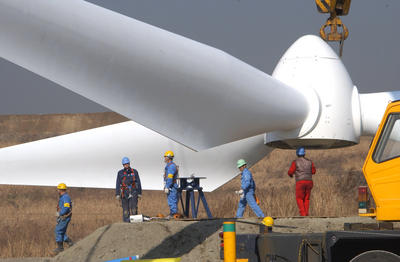Prior to the events of March 2011, Japan was on course to meet its Kyoto Protocol target of a 6 per cent reduction from 1990 levels by 2012. Although this was largely due to the recent sharp economic downturn, efforts by companies and households to reduce CO2 emissions and improve efficiency were also playing a significant role.
In the longer term, it was seen as difficult to achieve further emissions reductions through energy efficiency, and plans to invest in renewable energy were limited. Rather, Japan’s policies to achieve its more ambitious long-term emissions reduction targets (25 per cent by 2020, and 80 per cent by 2050) depended heavily upon expanded use of nuclear power. Fifty-four reactors provided 30 per cent of the country’s electricity, and plans would have seen this rise to 50 per cent by 2030, with at least 14 new reactors built.
But in the aftermath of the Fukushima Daiichi nuclear crisis, these plans have been abandoned, leading many observers to express severe doubts that Japan will meet its long-term emissions targets. The fear is that Japan will continue to rely upon fossil fuels to fill the current energy shortage, resulting in increased emissions for many years to come. Indeed, some Kan administration officials have already indicated that emissions reduction targets may be reviewed.
Reshaping climate policy
There is now wide consensus that significant changes are required to Japan’s domestic climate change mitigation policies. Debates acknowledge that the country had depended far too much on nuclear power, and seriously neglected renewable energy sources, which currently account for only 6 per cent of its energy. Prime Minister Kan has stated that renewables will become a major pillar of the country’s energy policy, along with energy savings.
Although significantly increased investment will be necessary in order for renewable energy to become practical, it would bring enormous benefits — a recent IPCC report suggests that renewable energy could account for 77 per cent of the world’s energy demand by 2050, if backed by the right public policies. For Japan, as well as wind and solar, its vast geothermal resources hold considerable potential. Japan may also explore possibilities to fully utilise its abundant forests as an energy source, even though biomass energy has been abandoned by many other countries.
While previously individuals and businesses recognised the need to reduce energy usage, they have now learned that energy savings are both possible and practical, even for a country that is already among the most energy-efficient in the world. In response to the immediate power shortfall after 11 March, Tokyo and surrounding areas have found innovative ways to reduce energy usage. Eighty per cent of member companies of the Japan Business Federation (Keidanren) are ready to meet the government’s 25 per cent reduction target during the summer months. Proposals include the establishment of a rotation system whereby various industries would take turns to temporarily shut down their factories.
Sustainability through reconstruction
With the total cost of the recovery estimated at $235 billion, 11 March was the world’s most expensive disaster. More than 250 billion yen has been budgeted for the initial removal of debris alone. Such an enormous drain on the country’s finances has the potential to affect not only domestic climate change policy, but also Japan’s commitments to provide adaptation assistance to developing countries.
Nevertheless, the post-disaster reconstruction process presents a unique opportunity for Japan to build more sustainable, low-carbon communities. Prime Minister Kan has proposed creating ‘eco-towns’ following the German model, which would also be highly resilient to natural disasters. Solar, wind, biomass and geothermal energy could be fully implemented, and local-scale ‘smart grids’ developed to solve the inherent difficulties in stabilising their fluctuating power outputs. Japan may also reconsider local industries — for instance, one government plan for the Tohoku region would consolidate over 200 tiny fishing ports into 11 large hubs.
The triple disaster has been an immense shock to Japan, and immediately cast doubt upon its ambitious climate change policies. But the resilience and resourcefulness shown by the Japanese people, and the government’s renewed commitment to developing renewable energy, suggest that the country need not abandon its target of an 80 per cent reduction in emissions by 2050.
As the reconstruction of the affected areas begins, the hope is that it will lead the way for Japan’s long-term shift towards a low-carbon economy — and ultimately a more sustainable society.
Kazuhiko Takeuchi is Vice Rector of the United Nations University (UNU) and Director of the UNU Institute for Sustainability and Peace.
Nicholas Turner is Academic Programme Associate at the United Nations University (UNU) Institute for Sustainability and Peace.


Yet even now daylight saving has not been attempted through the introduction of Summer Time, although some large companies may make the decision to vary the working day on an individual basis.